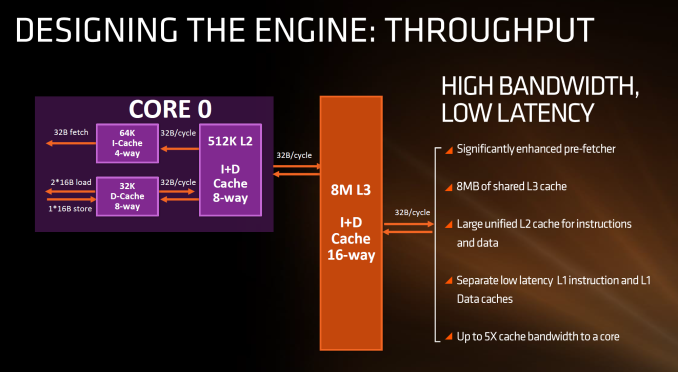AMD Zen Microarchitecture: Dual Schedulers, Micro-Op Cache and Memory Hierarchy Revealed
by Ian Cutress on August 18, 2016 9:00 AM ESTDeciphering the New Cache Hierarchy
The cache hierarchy is a significant deviation from recent previous AMD designs, and most likely to its advantage. The L1 data cache is both double in size and increased in associativity compared to Bulldozer, as well as being write-back rather than write-through. It also uses an asymmetric load/store implementation, identifying that loads happen more often than stores in the critical paths of most work flows. The instruction cache is no longer shared between two cores as well as doubling in associativity, which should decrease the proportion of cache misses. AMD states that both the L1-D and L1-I are low latency, with details to come.
The L2 cache sits at half a megabyte per core with 8-way associativity, which is double that of Intel’s Skylake which has 256 KB/core and is only 4-way. On the other hand, Intel’s L3/LLC on their high-end Skylake SKUs is at 2 MB/core or 8 MB/CPU, whereas Zen will feature 1 MB/core and both are at 16-way associativity.
Edit 7:18am: Actually, the slide above is being slightly evasive in its description. It doesn't say how many cores the L3 cache is stretched over, or if there is a common LLC between all cores in the chip. However, we have recieved information from a source (which can't be confirmed via public AMD documents) that states that Zen will feature two sets of 8MB L3 cache between two groups of four cores each, giving 16 MB of L3 total. This would means 2 MB/core, but it also implies that there is no last-level unified cache in silicon across all cores, which Intel has. The reasons behind something like this is typically to do with modularity, and being able to scale a core design from low core counts to high core counts. But it would still leave a Zen core with the same L3 cache per core as Intel.
| Cache Levels | ||||
| Bulldozer FX-8150 |
Zen | Broadwell-E i7-6950X |
Skylake i7-6700K |
|
| L1 Instruction | 64 KB 2-way per module |
64 KB 4-way | 32 KB 8-way | 32 KB 8-way |
| L1 Data | 16 KB 4-way Write Through |
32 KB 8-way Write Back |
32 KB 8-way Write-Back |
32 KB 8-way Write-Back |
| L2 | 2 MB 16-way per module |
512 KB 8-way | 256 KB 8-way | 256 KB 4-way |
| L3 | 1 MB/core 64-way |
1 or 2 MB/core ? 16-way |
2.5 MB/core 16/20-way |
2 MB/core 16-way |
What this means, between the L2 and the L3, is that AMD is putting more lower level cache nearer the core than Intel, and as it is low level it becomes separate to each core which can potentially improve single thread performance. The downside of bigger and lower (but separate) caches is how each of the cores will perform snoop in each other’s large caches to ensure clean data is being passed around and that old data in L3 is not out-of-date. AMD’s big headline number overall is that Zen will offer up to 5x cache bandwidth to a core over previous designs.











216 Comments
View All Comments
Jleppard - Thursday, August 18, 2016 - link
I like AMD and a fan. The agreement with Intel products Intel regardless if the allow someone else that would buy AMD from keeping X64 available to Intelfoobaz - Thursday, August 18, 2016 - link
Wouldn't the patents from their prior dispute be expired by now? That was a long time ago.Gigaplex - Thursday, August 18, 2016 - link
Some of them may have expired, but there are newer ones that haven't.wiak - Thursday, August 18, 2016 - link
AMD created AMD64 in 2000 and then released it in Athlon 64/Opteron then intel copied and called it EMT64 then everyone started calling it x86-64there is alot of references to amd64 in windows and ubuntu (amd64 isos etc)
https://en.wikipedia.org/wiki/X86-64#History
owan - Thursday, August 18, 2016 - link
Again, not a copy. They licensed it and branded it as their own thing.StormyParis - Thursday, August 18, 2016 - link
a legal copy is still a copy ?ianmills - Thursday, August 18, 2016 - link
Intel licensed the technology so they could copy it. I'm not sure what distinction you are tying to make :PMaybe you are trying to say Intel didn't steal the technology?
sorten - Thursday, August 18, 2016 - link
I think the point was in response to the OP, who was suggesting that AMD only ever copies Intel. The example of AMD64 is one where AMD was the innovator, though that's ancient history now.joex4444 - Thursday, August 18, 2016 - link
Nobody's disputing that AMD invented it. But what do you want Intel to do? Create their own and then all software companies have to support 32-bit, AMD64, and Intel64?Ej24 - Thursday, August 18, 2016 - link
Intel was close to releasing their own and gave up on consumer Intel64 when AMD beat them to market. Though I believe Intel still implemented it in some form in their Itanium brand?